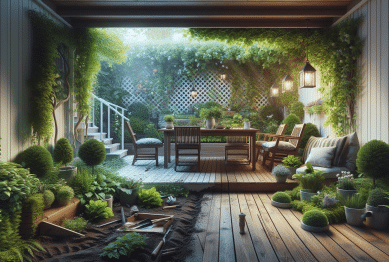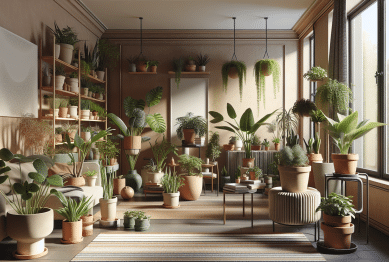Curious about making the most of limited space? Discover how vertical gardens turn compact home and garden areas into lush, thriving environments. This guide uncovers practical ideas, plant selections, and layout tips for maximizing space and greenery in creative ways.
Why Vertical Gardens Appeal in Modern Homes
Space often feels like a premium in modern homes, sparking the popularity of vertical gardens among creative homeowners. The beauty of a vertical garden is how it unlocks unused walls and tight corners, transforming them into lush, green focal points. For those living in apartments or homes with modest outdoor areas, vertical gardens provide a practical solution for bringing nature indoors or adding greenery to patios and balconies. Unlike sprawling traditional gardens, these upward-growing arrangements prove that maximizing space doesn’t mean compromising on beauty or plant variety.
Home gardeners find vertical plant walls convenient for managing herbs, flowers, and even vegetables without requiring a backyard. They fit seamlessly into city apartments, giving urban dwellers a slice of nature. These gardens take advantage of vertical real estate, turning balconies, fences, or kitchen walls into productive and eye-catching displays. For renters, vertical planters are often portable, offering flexibility and the freedom to enjoy gardening without permanent changes to the dwelling.
The visual impact of vertical gardens cannot be overstated. Green walls instantly add texture, movement, and color to spaces that once felt bland or cramped. The variety of designs—ranging from sleek living walls with automatic irrigation to simple DIY pallet planters—inspires creativity and personal expression. Whether it’s a statement piece above a sofa or a practical herb wall in the kitchen, these gardens offer both style and substance for the modern home. Explore further and see how vertical gardens can fit different lifestyles and spaces (https://www.gardeners.com/how-to/vertical-gardening/8683.html).
Choosing the Right Plants for Your Vertical Garden
Selecting plants is both fun and crucial for a successful vertical garden. Not all plants thrive in upright conditions, so it’s essential to focus on species known for adaptability and shallow root systems. Popular choices include lush ferns, cascading pothos, vibrant herbs like basil and thyme, and succulents for sunny balconies. These plants embrace the vertical structure, growing outward or downward to create a full, layered look. Considering light, moisture, and temperature needs helps ensure your selection will flourish together.
For edible vertical gardens, opt for salad greens, strawberries, or cherry tomatoes. These not only add visual appeal but also supply fresh ingredients for daily meals. Smaller root vegetables like radishes and baby carrots can fit as well. Mix textures and colors for a lively display; plants with trailing vines can soften edges while upright species add structure. Try to group plants by water and sunlight needs to streamline care and keep your wall healthy.
Native and drought-tolerant plants require less maintenance, making vertical gardens more sustainable. Using a mix that suits your local climate can reduce watering, support local biodiversity, and minimize the risk of pest problems. Some homeowners are drawn to air plants and moss, which need minimal soil and little more than indirect light and occasional misting. Researching your region’s microclimate goes a long way in helping plants thrive (https://extension.umn.edu/how-grow/vertical-gardening).
Designing a Functional and Stunning Vertical Garden
Good design begins with a plan. Assess the chosen space for sun, shade, and moisture before installing any system. Will the vertical garden live indoors, or will it greet guests by the front door? Measure and sketch the area, factoring in the weight of planters and saturated soil. It’s vital to select sturdy wall mounts or free-standing frames for safety and longevity. Modular systems are ideal for renters or for gardeners who love to rearrange their plantings as seasons—and inspiration—change.
Layering is key in vertical garden layouts. Start with a foundation of dense, slow-growing plants as a backdrop, and add cascading varieties for movement and depth. Balance colors to create visual harmony: mix cool-toned foliage plants with spots of vibrant blooms. For functional designs, create a dedicated kitchen herb wall or a privacy screen of vining perennials. Integrating irrigation systems, such as drip feeds or moisture-retaining substrates, can simplify plant care and encourage robust growth, particularly in larger living walls.
Accessibility and maintenance drive many design decisions. Plan for easy access to each plant for watering, harvesting, and pruning. Wall-mounted pockets, hanging bottles, and modular trays all provide distinct looks and maintenance approaches. Don’t overlook aesthetics. Select containers that match your style—rustic wood, sleek metal, or upcycled materials each add unique personality. Lighting, either natural or supplemental, supports plant health and brings drama to the display, especially after sunset (https://www.rhs.org.uk/advice/profile?pid=834).
Caring for a Healthy and Productive Vertical Garden
Vertical gardens require diligent but manageable care. Watering remains the top priority, as soil in vertical gardens can dry faster than in-ground beds. Automated drip irrigation systems or self-watering planters ease the burden of frequent watering. Fertilizing is also important; since nutrients leach quickly from vertical systems, consider monthly feeding with a balanced, slow-release formula. Mulching on top of pockets can help retain moisture and suppress pests.
Pruning and rotating plants keep your garden looking lively and prevent overcrowding. Regular grooming not only promotes good health but also stops any one species from taking over. Pests and diseases should be monitored, especially if the garden sits near open windows or outdoors. Many issues can be managed with simple, non-toxic solutions, such as soap sprays or neem oil. When introducing new plants or swapping out seasonal varieties, check for pests to avoid spreading problems throughout the garden.
Accessibility drives ongoing maintenance. Plan your vertical arrangement to allow for easy plant removal and tool access. Some systems include removable trays or easily swapped modules. If the garden is indoors, check for water runoff to prevent wall damage. Watching for warning signs like yellowing leaves or slow growth helps you act quickly. Communities and resources like local extension services offer tailored advice, making it easier to troubleshoot garden issues when they arise (https://hgic.clemson.edu/factsheet/vertical-gardening/).
Creative Ideas for Every Budget and Skill Level
From DIY enthusiasts to those who prefer ready-made solutions, vertical gardens cater to every passion and price point. Beginners often start with simple hanging shoe organizers filled with soil and herbs. Pallets—sanded and sealed—become rustic, sturdy vertical planters for flowers and greens. Modular kits found at local garden centers streamline setup, often including irrigation and mounting hardware.
For those with a larger budget or ambitious style, living walls featuring built-in lights, smart watering systems, or integrated hydroponics create showstopping features. Some homeowners opt for reclaimed windows or vintage ladders as plant supports, leaning into a more eclectic style that fits both home and garden. Wall trellises adorned with climbing roses or jasmine elevate outdoor patios—a fragrant, living privacy screen welcome in multi-family settings or townhouses.
Upcycled materials add sustainability and charm. Old gutters mounted on fences become thriving strawberry patches. Stackable crates offer ample pockets for trailing moss, ferns, or vibrant blooms. Reusing containers saves money, reduces waste, and encourages experimentation in plant placement and arrangement. For apartment dwellers, modular pocket panels turn bland walls into green oases and help cool indoor temperatures naturally (https://www.epa.gov/green-infrastructure/green-walls).
Environmental and Wellness Benefits of Vertical Gardens
Vertical gardens deliver more than just aesthetic value—they offer substantial environmental returns. Green walls act as natural insulation, reducing energy needs by helping keep indoor spaces cooler in summer and warmer in winter. In dense city settings, vertical gardens improve air quality by filtering particulate matter and absorbing carbon dioxide, enhancing both home and community environments.
Mental and physical wellness benefits are another reason for their growing adoption. Studies show that interacting with plants can lower stress and boost overall mood. People living among greenery report improved concentration and reduced anxiety. Vertical gardens, with their lush, living presence, create tranquil corners or bold, lively spaces that encourage mindfulness and relaxation in daily routines.
For families, these gardens become an educational tool, inspiring children to learn about nature, responsibility, and food sources. Even a small vertical setup can support pollinators or offer a sustainable way to grow food at home. Embracing such ecosystems at home fosters greater connectivity to the environment and promotes healthy living habits (https://www.sciencedirect.com/science/article/pii/S2210670717300524).
References
1. Gardener’s Supply Company. (n.d.). Vertical Gardening. Retrieved from https://www.gardeners.com/how-to/vertical-gardening/8683.html
2. University of Minnesota Extension. (n.d.). How to Grow: Vertical Gardening. Retrieved from https://extension.umn.edu/how-grow/vertical-gardening
3. Royal Horticultural Society. (n.d.). Advice: Vertical Gardens. Retrieved from https://www.rhs.org.uk/advice/profile?pid=834
4. Clemson Cooperative Extension. (n.d.). Vertical Gardening. Retrieved from https://hgic.clemson.edu/factsheet/vertical-gardening/
5. U.S. Environmental Protection Agency. (n.d.). Green Walls. Retrieved from https://www.epa.gov/green-infrastructure/green-walls
6. Burchett, M.D., et al. (2017). The Elements of Vertical Garden Benefits. Urban Forestry & Urban Greening, 27, 434-445. Retrieved from https://www.sciencedirect.com/science/article/pii/S2210670717300524









